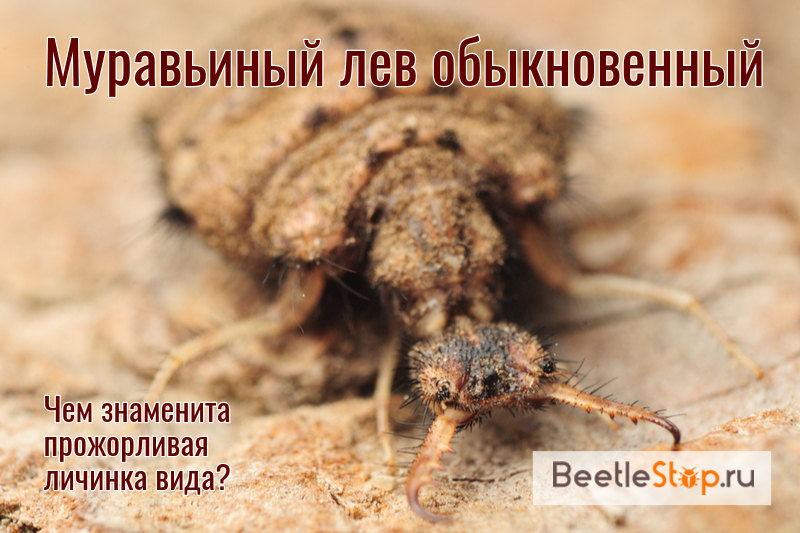Common ant lion - a predator of sandy shores
One of the largest representatives of the order of the retina is the ant lion. Insects of the Myrmeleontidae family have a wingspan of 50-90 mm. They are characterized by serious morphological differences between the imago and the larva. Adults are thin and graceful, and the offspring has a wide body with outgrowths and claw-shaped jaws. Ant lion is an ordinary typical species of the family. Its representatives are widespread in the steppe zone of Eurasia. The widespread development of sandy areas leads to a reduction in the number of these interesting insects.

View description
Common ant lion (Myrmeleonformicarius) belongs to the order of the retina, the genus Myrmelion, the family of ant lions. The adult individual resembles a dragonfly with a long thin abdomen and two pairs of transparent narrow wings. The head of the adult is vertical, the eyes are large, convex. Short antennae, which are organs of touch, end with a mace. The mouth apparatus is gnawing. The integument is soft. The chest is gray with black and yellow spots. Slender abdomen with a length of 20-28 mm darker color. The body is covered with rare blond hairs.
Information. The imagoes of an ant lion feed on nectar of flowers or live off the accumulations made by the larva.
The imago has 3 pairs of thin walking legs. The limbs are black with red spots. Paws and lower legs are covered with bristles. Wings are transparent with brownish veins. The length of the front is 35-40 mm, the rear is a little shorter. In a calm state, insects stack them roof-shaped along the body.
Distribution area
The common ant lion lives throughout Europe, except Great Britain. Reticulated insects are ubiquitous from Spain to the Far East. Common in the steppe zone of Asia. In Russia, the species is common in the European part before Karelia, found in the center and in the Caucasus.
Lifestyle
Adult behavior insects are completely unlike carnivorous predators. Adults prefer to sit on trunks and tree branches, slowly flying to another place only in case of danger. More active are the retina with dusk. At night, lamps or a bonfire fly into the light. The name of the ant lion family arose due to the lifestyle of the larva. A quick gluttonous insect lurks prey in hunting pits. The main diet of the larva is ants, but other arthropods cannot save the predator from the strong jaws.
The retina is settled in coniferous and mixed forests growing on sandy soil. Insects prefer open areas such as forest edges, wastelands of pine trees and roadsides. Larvae have sandy areas without vegetation. The adult's lifespan is from one day to several days. Their years begin in the second half of June. Offspring develops for two years.
Larval development
Females lay eggs in sandy soil. From the moment of birth, the larvae bury themselves in loose soil and arrange funnel-shaped traps. They dig a hole with the help of a head equipped with powerful elongated jaws. The predator hides at the bottom of the pit, waiting for the appearance of small insects. The body of the larva is oval, flattened. Coloring light brown with lots of black spots.The elongated head ends with crescent jaws, which have several notches on the inside. Inside the appendages there are hollow channels through which the digestive juice is injected into the sacrifice and the dissolved contents are sucked out.
The larva is waiting for prey in an ambush at the bottom of a sand funnel. If the victim stops at the edge or tries to escape, she begins to throw sand and small pebbles. Prey slides into the mouth of a hungry predator. For the larva, the size of the captured insect does not play a large role. Her digestive enzymes quickly paralyze the victim. After sucking the nutrient broth, the larva throws out an empty skin with its head.
Having reached the last age, she stops eating, from a silk thread from the end of the abdomen weaves a cocoon around herself for pupation. From the outside, grains of sand are glued to the sticky fibers, and a strong and reliable shelter for metamorphosis is obtained. In a spherical cocoon, the pupa is about four weeks old. The imago crawls out of the sand and spreads thin wings within half an hour.
Security measures
Due to the similarity of the species with other insects of the ant lion family, it is difficult to reliably establish the number of groups found. All finds consist of separate individuals. The development of open sands, overgrowing with grasses and shrubs, trampling of habitats on beaches and dunes contributes to a reduction in the number of retina. As protective measures, it is recommended to preserve the discovered habitats of the common ant lion, to limit the recreational load, and to prevent the burning. The species Myrmeleonformicarius is listed in the regional Red Books of several regions of the Russian Federation: Yaroslavl, Moscow, Vologda, Leningrad.


 (votes: 5, average rating: 4,80 out of 5)
(votes: 5, average rating: 4,80 out of 5)